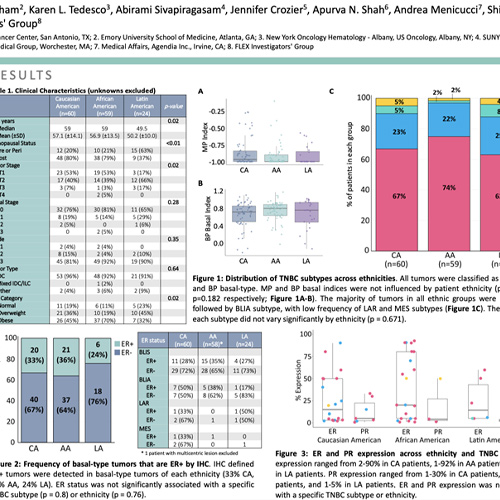PUBLICATION: 
ASCO 20
AUTHORS:
Virginia G. Kaklamani, Cathy Graham, Karen L. Tedesco, Abirami Sivapiragasam, Jennifer Crozier, Apurva N. Shah, Andrea Menicucci, Shiyu Wang, Michelle L. Bolner, Erin Yoder, William Audeh, FLEX Investigators’ Group
SUMMARY:
Triple negative breast cancer (TNBC) is an aggressive histological subtype with few targeted therapies and worse prognosis compared to other BC types. The heterogeneity of TNBC is underpinned by distinct transcriptional profiles including basal-like immunoactive (BLIA), basal- like immunosuppressed (BLIS), luminal androgen receptor (LAR), and mesenchymal (MES) subtypes [1]. These subtypes are associated with differences in survival and may assist in treatment decisions. Studies showed that African American (AA) and Hispanic BC patients have a higher frequency of TNBC tumors and worse survival rates compared to non-Hispanic Caucasian BC patients [2]. Furthermore, previous studies report a significantly higher frequency of BLIS subtype tumors in Hispanic TNBC patients, higher frequency of BLIA and BLIS subtypes in AA TNBC patients, and higher frequency of LAR subtype in Asian American and European American TNBC patients [3-4].
The 80-gene BluePrint assay genomically defines breast tumors as basal, luminal, or HER2-enriched independently of IHC expression. Here, we report the distribution of TNBC subtypes in BluePrint-defined basal tumors from Caucasian American (CA), African American (AA), and Latin American (LA) patients, and the association of estrogen receptor (ER) positivity by immunohistochemistry (IHC).
Read more: ASCO 2020: TNBC Subtype

